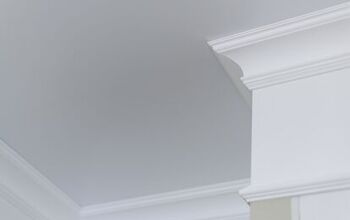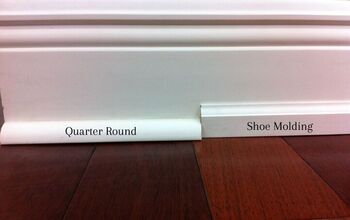Bed Molding Vs. Crown Molding: What Are The Major Differences?
Molding of all kinds can be used to add a nice decorative touch to any home. Used to cover the joint between the ceiling and wall, this decorative trim adds nice shadow lines and makes kitchens, dining rooms, and living rooms look more ornate.
To the untrained eye, moldings tend to all look similar in design. But upon closer inspection, moldings come in many different designs, and offer slightly different functions. It can be especially difficult to tell the difference between bed molding and crown molding. So, how do these two types of molding compare to each other?
Both bed and crown moldings are placed in corners where the ceiling meets a wall. But bed molding tucks more tightly into a corner and has less of a shadow line than crown molding. Crown molding juts out from the wall more, while bed molding can be flush to the wall as an extension of a cornice mold.
Do You Need Interior Trim or Decorative Molding Installation?
Get free, zero-commitment quotes from pro contractors near you.

What is the Function of Molding?
Today, molding is primarily installed as decorative trim. But its original use was more pragmatic than this. Molding was initially used to cover gaps and imperfections where ceilings and walls came together. Back when homes had more crevices in their construction, applying these rudimentary wooden trimmings was a quick fix.
Over time, the designs got more ornate, and now provide beautiful accents to common rooms. And depending on the labor costs of installing molding, it can also add value to a home. If the style suits the home’s current architecture and out-of-pocket expenses don’t run too high, it can increase home value by around $500. This isn’t a significant ROI, but it’s something to consider.
What is Bed Molding?
Bed molding is trim designed to be tightly tucked into a corner where a horizontal surface meets a vertical surface. Similar to crown molding, it’s meant to add a decorative touch to the interior or exterior of your home, and to cover corner joints.
Bed molding is used as a transition above the frieze, placed immediately beneath the corona of a cornice. Bed molding can be flush to the wall as an extension of a cornice mold. It can also be sprung or plain. More often than crown molding, bed molding is used for doorways, cabinets, and even windows.
It has more of a shadow line than a simpler cove molding, but less of a shadow line than crown molding. It also tends to stay pretty simple in its mixed concave and convex cuts, and doesn’t vary as much in length and size. Bed molding usually comes in a wood or polystyrene material.
What is Crown Molding?
Crown molding, like bed molding, is a ceiling trim typically used for decorative purposes. It can also help visually lift a room, drawing your eyes upward to make the ceiling appear higher. Crown moldings are often made of plaster, because these templates are easier to recreate than carved wood.
Because crown moldings often have complex designs, the cuts are harder to mass-replicate. But wood moldings are easier to install than plaster, and less prone to cracking. Perhaps the easiest and most affordable crown molding to install is a composite material, such as polystyrene, vinyl, or PVC.
The styles of crown molding vary widely by profile, size, and curves. It is usually a combination of convex and concave cuts, and may incorporate a cove. They tend to be more visually apparent in a room than bed molding, as they curve outward rather than tuck inward.
Bed Molding vs. Crown Molding – Major Differences
There’s no denying that bed molding and crown molding look similar, and serve similar functions. But while that may be so, there are a few differences to be aware of when deciding which trim to go with. Let’s explore bed molding vs crown molding a bit further.
- Crown molding tends to vary more in length, size, and profile.
- Crown molding juts out from the wall more than bed molding.
- Bed molding tucks into a corner more tightly.
- More ornate designs are available with crown molding than bed molding.
- A bed molding can be flush to the wall, whereas crown molding is usually not.
- The materials sometimes differ. While crown moldings are sometimes made with plaster molds due to their complex designs, bed moldings typically come in wood or composite.
The main differences come down to your visual tastes. If you want to transform a room by adding ornate features, crown moldings offer more options for this. If you like it clean and simple and need a nice frieze transition, bed moldings might be a good choice.
How to Choose Molding Paint Colors and Styles
The visual style of your molding choice will depend on the room it’s being installed in. If you’re working with a really small room with low ceilings, simpler and slimmer is better. Chunky, ornate crown moldings in small spaces tend to look oppressive. The larger and taller the room, the larger and more complex moldings you can pull off.
As for color, it’s a good idea to paint your moldings the same color as the walls to visually lift up the ceiling. You can also match the molding color to the ceiling. Lighter colors are effective at brightening and opening up a room, so keep that in mind.
As for architectural styles, you can always refer to an interior designer or catalog dedicated to molding styles. Designs run the gambit from Classic Colonial, Greek Revival, Deco, and many more. You don’t have to know it all, so refer to the experts when help is needed.
How Much Do Bed and Crown Moldings Cost?
The cost of molding will really depend on how much you need, what material you’re purchasing, and which type you opt for. Molding is typically priced per linear foot of material. In general, crown molding is a bit more expensive per linear foot than bed molding, but this depends on material.
If you’re set on crown molding, here’s what you can expect to pay per linear foot of each material type plus labor costs:
- Composite (PVC, Polyurethane, Polystyrene): $3.50 – $10 per linear foot
- Solid wood: $5 – $12 per linear foot
- Plaster: $9 – $20 per linear foot
- Metal: $13 – $33 per linear foot
Interested in purchasing bed molding? The varying prices are similar to those of crown molding. For example, the cheapest option for bed molding is Polystyrene material, sold at Lowe’s for $5.30 per linear foot. Painted PVC bed molding is also sold at Lowe’s for $10.44 per linear foot. The most expensive option is oak wood molding, at $16.40 per linear foot.
Do You Need Interior Trim or Decorative Molding Installation?
Get free, zero-commitment quotes from pro contractors near you.

Related Questions
Why is crown molding separating from the ceiling?
Crown molding can actually start separating from the ceiling and wall. Extreme humidity and temperature changes most often contribute to this, due to the ceiling tresses contracting and pulling up the ceiling. There may also be a case of termites within the wall that are eating away at the wood and caulks.
Why is molding cut upside down and backwards?
Using a miter saw, the crown molding must be tipped on the saw to replicate the “sprung” angle it will have when it’s installed. This means that the narrow edge that’s meant to rest against the wall will be against the saw fence, and the top edge that’s meant to rest against the ceiling should rest on the saw table. Most conventional miter saws don’t tip to compound angles, so flipping it upside down helps create these angles.
What is a crown molding spring angle?
A crown molding spring angle is the angle measured from the back of the molding to the wall when held tightly against the wall. You can use either edge of the crown molding when taking this measurement.
Related Guides
More by Jessica Vaillancourt



























